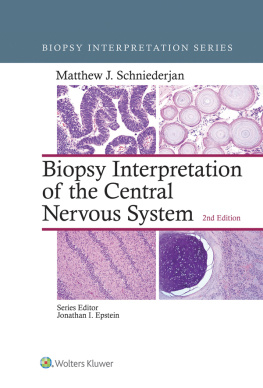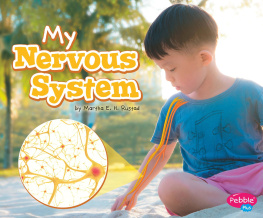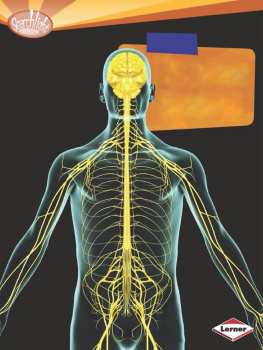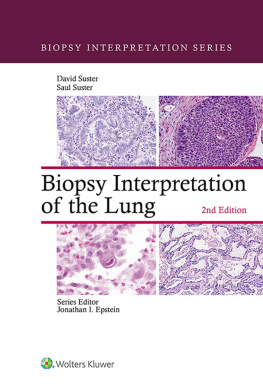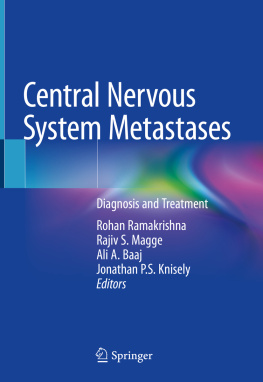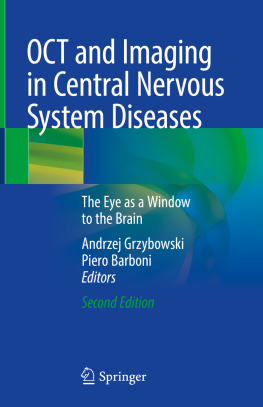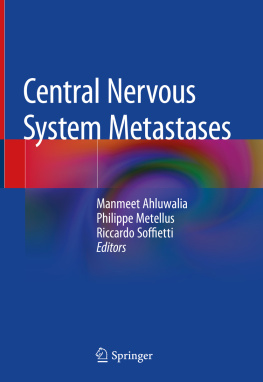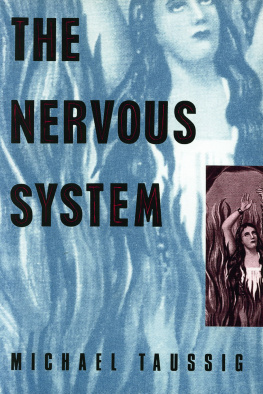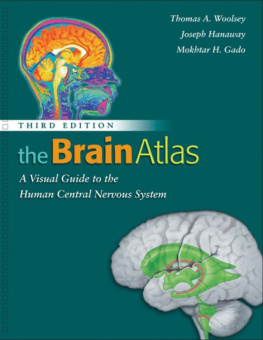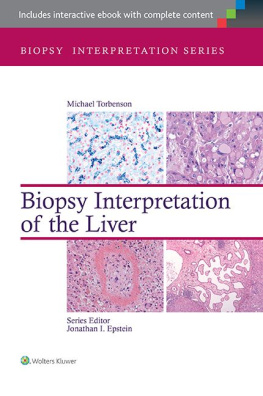Contents
Guide

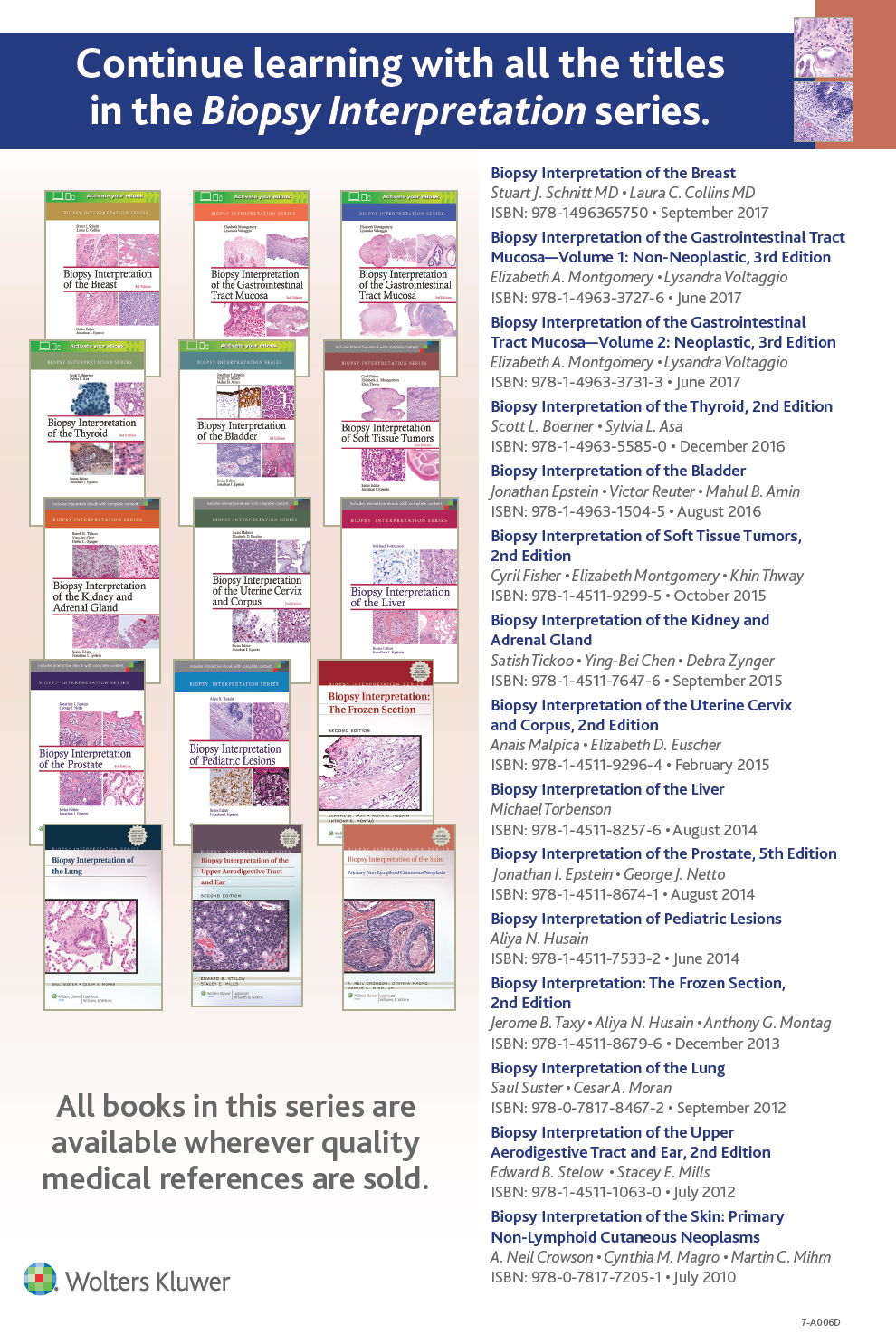
BIOPSY INTERPRETATION SERIES
BIOPSY INTERPRETATION
OF THE CENTRAL
NERVOUS SYSTEM
Second Edition
Matthew J. Schniederjan, MD
Neuropathologist
Childrens Healthcare of Atlanta
Assistant Professor
Department of Pathology and Laboratory Medicine
Emory University School of Medicine
Atlanta, Georgia

Acquisitions Editor: Ryan Shaw
Editorial Coordinator: Alexis Pozonsky
Marketing Manager: Dan Dressler
Design Coordinator: Stephen Druding
Production Product Manager: Bridgett Dougherty
Manufacturing Coordinator: Beth Welsh
Prepress Vendor: Aptara, Inc.
2nd edition
Copyright 2018 Wolters Kluwer
2011 LIPPINCOTT WILLIAMS & WILKINS, a WOLTERS KLUWER business
All rights reserved. This book is protected by copyright. No part of this book may be reproduced or transmitted in any form or by any means, including as photocopies or scanned-in or other electronic copies, or utilized by any information storage and retrieval system without written permission from the copyright owner, except for brief quotations embodied in critical articles and reviews. Materials appearing in this book prepared by individuals as part of their official duties as U.S. government employees are not covered by the above-mentioned copyright. To request permission, please contact Wolters Kluwer at Two Commerce Square, 2001 Market Street, Philadelphia, PA 19103, via email at (products and services).
9 8 7 6 5 4 3 2 1
Printed in China
Library of Congress Cataloging-in-Publication Data
Names: Schniederjan, Matthew J., author.
Title: Biopsy interpretation of the central nervous system / Matthew J. Schniederjan.
Other titles: Biopsy interpretation series.
Description: Second edition. | Philadelphia : Wolters Kluwer, [2018] |
Series: Biopsy interpretation series | Includes bibliographical references and index.
Identifiers: LCCN 2017039563 | ISBN 9781496397775
Subjects: | MESH: Central Nervous System Diseasesdiagnosis | Central
Nervous System Diseasespathology | Central Nervous Systempathology | Biopsymethods
Classification: LCC RC386.6.B55 | NLM WL 141 | DDC 616.8/04758dc23
LC record available at https://lccn.loc.gov/2017039563
This work is provided as is, and the publisher disclaims any and all warranties, express or implied, including any warranties as to accuracy, comprehensiveness, or currency of the content of this work.
This work is no substitute for individual patient assessment based upon healthcare professionals examination of each patient and consideration of, among other things, age, weight, gender, current or prior medical conditions, medication history, laboratory data and other factors unique to the patient. The publisher does not provide medical advice or guidance and this work is merely a reference tool. Healthcare professionals, and not the publisher, are solely responsible for the use of this work including all medical judgments and for any resulting diagnosis and treatments.
Given continuous, rapid advances in medical science and health information, independent professional verification of medical diagnoses, indications, appropriate pharmaceutical selections and dosages, and treatment options should be made and healthcare professionals should consult a variety of sources. When prescribing medication, healthcare professionals are advised to consult the product information sheet (the manufacturers package insert) accompanying each drug to verify, among other things, conditions of use, warnings and side effects and identify any changes in dosage schedule or contraindications, particularly if the medication to be administered is new, infrequently used or has a narrow therapeutic range. To the maximum extent permitted under applicable law, no responsibility is assumed by the publisher for any injury and/or damage to persons or property, as a matter of products liability, negligence law or otherwise, or from any reference to or use by any person of this work.
LWW.com
DEDICATION
To my wife, Stephanie, whose patience and kind support made this work possible.
PREFACE TO THE FIRST EDITION
This new book carries on a strong tradition of diagnostically oriented texts established by the Biopsy Interpretation Series, in the present case focused on lesions of the central nervous system. Our purpose is to provide a practical guide and concise reference that can be a companion text for general surgical pathologists, trainees in pathology and neuropathology, and clinicians who treat patients with neurologic diseases that require surgical sampling. Given the heavy orientation of the Biopsy Interpretation Series to the busy and serious-minded diagnostician, we have taken this opportunity to create something new and, we think, useful. While there are certainly several excellent books on neuropathology and surgical neuropathology, the majority are reference texts that are comprehensive and encyclopedic, making them less than optimal on a daily basis to assist with interpretation. Because the central concern here is with establishing the correct diagnosis, the content is aimed at anticipating difficult diagnostic decisions and providing a direct and reliable guide to their resolution.
The text contains relatively little discussion of historical background, disease mechanisms, or basic research findings unless they are clinically relevant. Rather, the emphasis is on highlighting the distinguishing histologic features and helpful ancillary testing necessary to make a confident and competent diagnosis, as well as to place each lesion in the setting of its clinical significance. For the discussion of neoplastic diseases, we have relied on the most current World Health Organization Classification of the Central Nervous System, 4th edition, as our guide for classification and grading.
Current practice of surgical neuropathology, perhaps more than most pathologic subspecialties, requires knowledge of the clinical and neuroimaging features of a lesion to generate a differential diagnosis. The differential diagnosis of a sellar/suprasellar lesion in a teenaged girl is completely distinct from that of a frontal lobe lesion in a middle-aged man. While slapping the H&E-stained slide on the stage in the absence of clinical and imaging context may occasionally suffice for a correct diagnosis (craniopharyngioma comes to mind), in the long run this practice will almost certainly generate anxiety, uncertainty, and less than adequate diagnoses. To emphasize this necessity in practice, we have started the discussion of each individual entity with a section on Clinical Context, setting the stage for discussion of histopathologic features, ancillary studies, and differential diagnosis, maximizing the efficiency and utility of the book as both a reference and a tool for education.
Matthew J. Schniederjan, MD
Daniel J. Brat, MD, PhD
PREFACE TO THE SECOND EDITION
In the years since the publication of the first edition of this book, as a result of large-scale efforts to understand the genetics of brain tumors, surgical neuropathology has shifted further toward a multifaceted approach to tumor categorization, similar to the field of hematopathology. This is evident in the updated 4th edition of the

